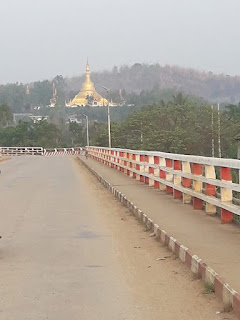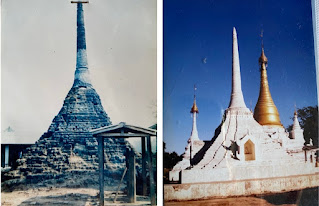N 131 – Domestic Travels (to Shweli)
My eldest daughter Ying’s in-laws are from Mo Gyo Pyit village, located in Pyin Oo Lwin township. The elderly couple would often visit and stay with us in Yangon during the winter. The mother-in-law had a brother who was an abbot—referred to as “Na Sang”—residing at Loi Kyaung Seng Monastery in Shweli, across the border in China. Occasionally, the in-laws would travel to visit Na Sang and would invite us to join them on these trips.
The farthest I had ever been in Northern Shan State was Pyin Oo Lwin (formerly Maymyo). Since I had never been beyond that point—especially not to the border—I decided to join them on this trip. There was to be a novitiation ceremony around the full moon day of Tabaung, and since Na Sang had invited many family members and friends from Mo Gyo Pyit, a large group planned to go. I don’t remember how many cars we used, but I do remember the excitement and panic I felt while crossing the winding and treacherous Gokteik road.
After passing through many towns I was familiar with, we eventually reached Muse, where we spent the night. The next morning, after obtaining our passes to enter Chinese territory, we crossed the border gate. About an hour later, we arrived at Loi Kyaung Seng Monastery, perched on a hill above a Shan village.
Though it was already March, the weather was still cold. Fortunately, the monastery was well-prepared for guests, with piles of warm bedding. Villagers had been preparing food for days. In the lead-up to the ceremony, we were served simple dishes such as cabbage, mustard greens, and a soup made with samounsapa (စမုံစပါး), which was unfamiliar to us. Besides guests from Myanmar like ourselves, locals also arrived by the busload—not only from nearby villages but even from as far as Manshi city, about 60 miles away.
The people living in the area are Tai Nuer (whom we refer to as Shan Tayoke). While we share the same Shan language, their accent is quite different, often making it difficult to understand one another. Still, we managed to communicate, even if not every word was clear. Most of the festival attendees were elderly, predominantly women, all dressed in black clothing with matching black turbans.
The monastery grounds had turned into a vibrant festival area. There were stalls selling foods such as khou moon haw, khou moon larm, and other Shan snacks that reminded me of Kunhing. Vendors sold clothing, household items, and a variety of goods that attracted the crowds. Like many small festivals, there were also mini gambling stalls—roulette wheels and dice games betting on four or six animals. These were so tempting that it was hard to resist going near.
What impressed me most was the group dance performed by villagers in the monastery compound. Nearly everyone at the festival formed a large circle and danced to the rhythmic beat of drums and cymbals, moving in unison without breaking the circle. Most participants were women, and during the peak of the festival, there were several dancing circles. At the time, this style of communal dance wasn’t yet popular in our country—but in recent years, similar dances have gained popularity, especially to songs like Koan Kar… Koan Kar…

After the novitiation ceremony concluded and the young novices were robed in their thingan, the event came to an end. The next morning, Na Sang took us to visit Manshi. As mentioned earlier, the city is about 60 miles from Ruili, and it took us a while to get there. On the way, we stopped to pay homage at some pagodas with Chinese architectural styles. However, upon reaching Manshi, there wasn’t much to see. I had hoped to meet more of the black-clad Tai Nuer people, but it seems they could only be found in their villages. The townspeople were mostly ordinary Chinese residents dressed in casual attire. We had lunch near a bazaar and wandered around the market, which was rather quiet. Some shopkeepers had small tables set up in front of their shops where they played mahjong or card games.

After returning across the border to our guesthouse, we decided to explore a new destination. Instead of visiting Namkham, we chose to go to Kyu Kok Pan Saing, about 30 miles from Muse. In hindsight, this was not the best decision. As our cars traveled along the road, we didn’t see any people or other vehicles. The area seemed deserted. A sense of unease crept in, and although no one voiced it aloud, we all felt the same apprehension. Thankfully, our worries turned out to be unfounded—we arrived and returned safely. However, I remember nothing of the town itself, except for the simple fact that I had once been there.
The next morning, as I sat in the car for the homeward journey, I reflected on an experience filled with chilly memories and warm sensations. We had set out early, when the cold seemed to bite more sharply than it had the days before. Thankfully, I had a trusty pair of socks tucked away, offering a small but comforting warmth to an otherwise frosty morning.
After some time, we reached a roadside eatery in Hsenwi Township. By then, the sun had made its appearance, casting a golden glow over the buffet spread that awaited us. Simply being there seemed to melt away the lingering chill in the air, igniting our appetites.
The curries we indulged in were nothing short of delicious—a delightful fusion of Tai and Chinese flavors. Even now, the taste lingers in my memory. It’s this lingering warmth and richness that I want to capture in words, marking the perfect close to this blog.














.jpeg)











.jpg)














